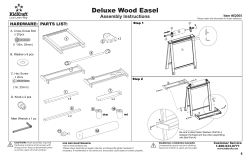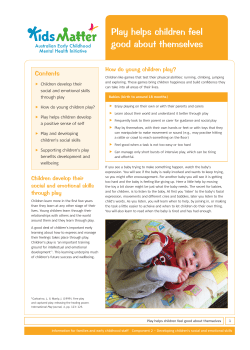
Interactive play and communication for children on the autistic spectrum
Interactive play and communication for children on the autistic spectrum Aims: To enable the child to realise the pleasure of shared fun To give purpose to communication To encourage spontaneous communication To achieve basic interaction with the child To extend a child’s ability to play with / explore materials Through play to help the child to develop understanding and language To develop sustained attention. To begin with the adult plays alongside the child: Ensure that the child will tolerate your presence, staying close for a short time to begin with and gradually extending the time. Comment as you play but do not expect a response yet. Comment on the child’s activity too (e.g. “you’re building a big tower, one, two, three, four, five blocks”). Get into the habit of announcing your arrival in some way and say “goodbye” as you leave (even if he/she seems to ignore you). Copy the child in actions and verbalisations. Look at him to see if he’s noticed you are copying. If he is, try doing something simple and looking to see if he will copy you. You may need to exaggerate a bit to be noticeable. Once you have played some copying games you can add some new things in to extend the play. Keep any verbalisations during play very simple, e.g. “up, up, up, woosh”, “weee”, “vroom”, “oh dear.” Try swapping toys and then continuing to play. You might say, “my turn” and hold out your hand for his toy. If he gives it to you say “thank you” and give it back very quickly saying, “Your turn.” Making sure you at the child’s level, hold something interesting near your eyes and say, “Look.” Try to build in a response, e.g. hand up to stop him pouring the sand and saying, “Ready, steady, go.” As he gets used to this pause before “go” to build up anticipation then hope for a verbal exclamation, a shared glance, a smile etc. If the child takes you by the hand to show you something, go along and show interest, talking about it. Use your hand over his hand to introduce actions and understanding of the vocabulary: push, pull, twist, turn, etc. Doing things together: At singing time sit with the child between your legs and reach forward to help her make the actions hand over hand. Do the same with musical instruments. ©NCC-The Autistic Spectrum Team, 2009 Page 1 V005 Rough and tumble games / boo games/ tickling games such as round and round the garden. In all of these try to gain some eye contact by pausing to build up anticipation. Smile and laugh and help the child to see that you are enjoying this too. If eye contact is not given try playing a physical game where he is almost forced to look at you, e.g. spinning him round and then stopping him and looking at him. Play this until he learns that he can stop the spin by looking at you then you can play this game with real communication and under his control. Other games such as Horsie, horsie, Patacake, This is the way the lady rides, Incy wincy spider and action rhymes are good because they are predictable. Develop interactive games where you face each other, e.g. rolling a ball to each other, row row the boat. Play silly singing games, e.g. “Where is Tricia, I can’t see Tricia, where is she?.Where is she?”...........”Oooh! there you are!” Using coloured beakers, put them upside down in a line or circle and hide different objects under them. Begin to slowly turn them over and exclaim each time at what is there. The child should gradually join the game and may show in face, body or verbal expression, surprise or pleasure which you can join in with. Imitate the sounds she makes, e.g. coughs, sneezes, car noises etc. This teaches the child to imitate in turn. You can also imitate sounds as they happen e.g. gurgle for water going down the plug hole, swish for the toilet flushing, woof when a dog barks etc. Play an imitation game, e.g. looking at a farm animals book and pointing at an animal and saying the sound, or copying her if she says the sound. You imitating her is the best form of this game as she is initiating it. These games can go on to be quite sophisticated as long as you are both finding it fun. Help the child to be more tuned in to listening by having sessions with things that make noises: listening to e.g. cellophane rustling by his ear and then your ear and making a reaction to the sound. Take it in turns to make sounds with different materials. Try listening to a ticking clock, to a biro clicking, to a telephone dialling tone, to a squeaky toy. You could play a listening game too, e.g. hiding the sound maker behind him / under the table. Can he find where it is? Reward him with the toy etc. Compare sounds e.g. the sounds of dried beans, lentils and rice as they are poured and shaken. Sometimes have a noisy session with loud noises (rattling cans, jingling bells, drums, tambourines etc) as long as the child is able to tolerate this. Play matching games to help him look at pictures and things and notice them, e.g. photographs with the actual objects (e.g. teddy, cash register, play spoon, car, necklace, etc). Join in when the child is playing with ,e.g. a train track. Play alongside to begin with and then make a station. Stop your train at the station then puff off again. See if he will copy you. Offer him a truck for his engine to pull. Bring your engine up after his and chant “I’m catching you, I’m catching you” and see if he responds. Try stopping your train suddenly and exclaiming, “Oh no my train has broken down.” See what he does. Try asking him to fix it. And so on! ©NCC-The Autistic Spectrum Team, 2009 Page 2 V005 Problem solving when the child is not engaging in play: Try to look at it from the child’s point of view. Could he find the texture uncomfortable? Is it too complicated a process? Are the pieces too small for him to easily manipulate? Is there just too much stimulation and choice? Try just having one toy at a time in a quiet room. Are the toys just too advanced for his level of development? Try materials which are more sensory based: things to sniff and feel as well as see and hear. Are you rushing her? Don’t try to hurry the child on: give her time to explore materials and get used to them. Is she not realising you are playing with her? Exaggerate responses until the child takes notice. Are these play materials that the child has no experiences of? Model how to play with the material (simply). Are other children proving a distraction or threat? Only introduce another child to the shared play activity when you feel the child with autism is confident in playing with those materials with you. Is she intent on her own activity? Try to stimulate her interest by playing with a toy yourself and commenting / singing about it as if you were another child playing at a simple level. Is she reluctant to play with the toys on offer? Start playing with familiar materials, and then introducing something new slowly. IEP targets could include: Establishing eye contact in a shared game Giving attention to sharing a play material (book, toy, picture etc) with an adult Taking turns in using play materials Imitating sounds and actions when playing with an adult or child Engaging with play tasks for 2/5/10 minutes etc. Showing something to an adult (pointing, taking by the hand, giving etc). Extending play by suggesting a new aspect for a playmate to follow. Some useful books: “Early Intervention for children with socialisation and / or communication difficulties” by Steve Flynn, Barbara Daff and Jenny Tarry. Publ. by NCC. (A book of ideas for different problems) “Interactive Play” from the Frameworks for Communication series, Fineprint (Nottingham) Ltd. (provides simple explanations and practical ideas). “Sharing Conceptual Play” ditto. “Developing Pupils’ Social Communication skills” by P.Barrat et al. Publ David Fulton. (A book of games and ideas) Visit our website for details work we do in schools, parent help, resources, useful links, training, how to contact us: http://www.northamptonshire.gov.uk/autismteam - Training: Tel: 01604 857386 or email NIP@northamptonshire.gov.uk ©NCC-The Autistic Spectrum Team, 2009 Page 3 V005
© Copyright 2025





















